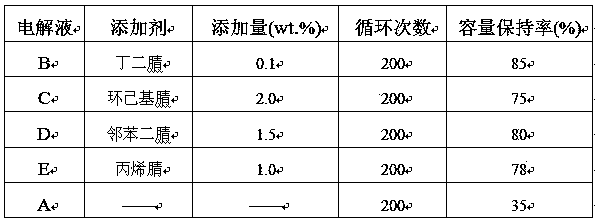Electrolyte for 4.5 V lithium ion battery
A lithium-ion battery and electrolyte technology, applied in secondary batteries, circuits, electrical components, etc., can solve the problems of low charging and discharging efficiency of lithium-ion batteries, poor cycle performance, and restrictions on the development of high-voltage lithium-ion batteries, and achieve improvement High-pressure cycle performance, not easy to decompose, and obvious effect
- Summary
- Abstract
- Description
- Claims
- Application Information
AI Technical Summary
Problems solved by technology
Method used
Image
Examples
Embodiment 1
[0012] Lithium-ion battery electrolyte that is not easy to decompose under 4.5V high voltage, including a nitrile compound, which is succinonitrile, when the high-voltage additive is used in the lithium-ion battery electrolyte, the mass percentage of the electrolyte 0.1%. The organic solvent in the electrolyte is a mixture of ethylene carbonate (EC), dimethyl carbonate (DMC) and ethyl methyl carbonate (EMC), where the mass ratio of EC, DMC and EMC is 40%:40%:20% . The electrolytes of Li-ion batteries were 1.0 M LiPF 6 It is denoted as electrolyte B, and the electrolyte without additives is denoted as A.
[0013] Inject A and B electrolytes into the positive electrode LiCoPO 4 , In an aluminum case lithium-ion battery with an artificial graphite as the negative electrode (nominal capacity is 650Ah), a 0.5C charge-discharge cycle is performed within the voltage range of 3.0~4.5V. The capacity retention rate of the battery using A electrolyte is about 35% after 200 cycles, w...
Embodiment 2
[0015] The lithium-ion battery electrolyte that is not easy to decompose under a high voltage of 4.5V contains a nitrile compound, which is cyclohexyl nitrile. When the high-voltage additive is used in the lithium-ion battery electrolyte, the proportion of The mass percentage is 2.0%. The organic solvent in the electrolyte is a mixture of ethylene carbonate (EC), dimethyl carbonate (DMC) and ethyl methyl carbonate (EMC), where the mass ratio of EC, DMC and EMC is 40%:40%:20% . The electrolyte of Li-ion batteries is 1.0 M LiPF 6 Denoted as electrolyte C.
[0016] Inject the C electrolyte into the cathode LiCoPO 4 , In an aluminum case lithium-ion battery with an artificial graphite negative pole (nominal capacity is 650Ah), a 1C charge-discharge cycle is performed within the voltage range of 3.0~4.5V. After 200 cycles of electrolyte battery cycle, the battery capacity retention rate reaches more than 75%.
Embodiment 3
[0018] The lithium-ion battery electrolyte that is not easily decomposed under a high voltage of 4.5V contains a nitrile compound, which is phthalonitrile. When the high-voltage additive is used in the lithium-ion battery electrolyte, the The mass percentage accounted for is 1.5%. The organic solvent in the electrolyte is a mixture of ethylene carbonate (EC), dimethyl carbonate (DMC) and ethyl methyl carbonate (EMC), where the mass ratio of EC, DMC and EMC is 40%:40%:20% . The electrolyte of Li-ion batteries is 1.0 M LiPF 6 Denoted as electrolyte D.
[0019] Inject the D electrolyte into the positive electrode LiCoPO 4 , in an aluminum case lithium-ion battery with artificial graphite as the negative electrode (nominal capacity is 650Ah), 1C charge-discharge cycle is performed in the voltage range of 3.0~4.5V, and the battery capacity retention rate of the battery after 200 cycles of the electrolyte reaches more than 80%. .
PUM
 Login to View More
Login to View More Abstract
Description
Claims
Application Information
 Login to View More
Login to View More - R&D
- Intellectual Property
- Life Sciences
- Materials
- Tech Scout
- Unparalleled Data Quality
- Higher Quality Content
- 60% Fewer Hallucinations
Browse by: Latest US Patents, China's latest patents, Technical Efficacy Thesaurus, Application Domain, Technology Topic, Popular Technical Reports.
© 2025 PatSnap. All rights reserved.Legal|Privacy policy|Modern Slavery Act Transparency Statement|Sitemap|About US| Contact US: help@patsnap.com

